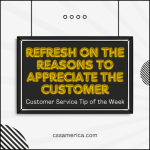It’s the never-ending battle between marketing and customer service. Marketing makes promises, and customer service has to deal with upset customers when the company doesn’t deliver. To ensure we deliver on promises, let’s assess promises by looking at some famous quotes over time…
Promises may get Friends, but ‘tis Performances that keep them. Thomas Fuller
Why you gained a customer is not necessarily why you will keep that customer. Typically, that carrot that leads the customer to your organization is not based on their personal experiences with your business. But their personal experiences are what determine whether they come back or not.
Don’t ever promise more than you can deliver, but always deliver more than you promise. Lou Holtz
Promises in business create expectations, so it’s better to under promise and over deliver. Remember, the difference between an expectation and reality is a problem when the expectation is greater than the reality. Make the reality a little greater than the promise.
Let your yes be yes and your no be no. James
Just like you need to be clear with the customer about what you can do, be clear with them about what you cannot Don’t give the customer the impression that you can hit a deadline when you probably cannot, that you can process a full refund when you probably cannot, that you can fix a problem exactly how they’ve defined the solution when you know you cannot. Don’t create your own issues.
An ounce of performance is worth pounds of promises. Mae West
The ultimate judgment of an organization is their performance. The lasting impression of an organization is much more likely to be based on the last impression or experience rather than the initial promise.
Deliver on promises by under promising at the start. By looking for ways to deliver a little bit more. By being clear when you cannot do something. By understanding that performance is what makes the lasting impression.
Exceed the Promise.
Signup for FREE Tips! Contact Us More Resources for You Visit Our Home Page
























